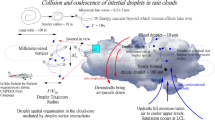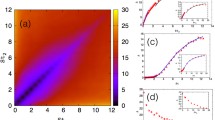Abstract
We describe an experimental setup aimed at studying turbulent-induced droplet collisions in a laboratory setting. Our goal is to reproduce conditions relevant to warm-rain formation in clouds. In these conditions, the trajectories of small inertial droplets are strongly influenced by the background air turbulence, and collisions can potentially explain the droplet growth rates and spectrum broadening observed in this type of clouds. Warm-rain formation is currently under strong scrutiny because it is an important source of uncertainty in atmospheric models. A grid at the entrance of a horizontal wind tunnel produces homogeneous isotropic turbulence at a Re λ in the range of 400–500. Water droplets are injected from the nodes of the turbulence-inducing grid at a volume fraction (ϕ) of 2.7 × 10−5 and with sizes of 10–200 μm. A complex manifold-injection system was developed to obtain uniform water droplet seeding, in terms of both water content and size distribution. We characterize the resulting droplet-laden turbulent flow, and the statistics of droplet pairs are measured and analyzed. We found that the radial distribution function (RDF), a measure of preferential concentration of droplets that plays a key role in collision kernel models, has a large peak at distances below the Kolmogorov microscale of the turbulence. At very long separations, comparable with the integral length scale of the turbulence, these RDFs show a slow decay to the average probability given by the mean droplet number density. Consistent with this result, conditional analysis shows an increased local concentration of droplets within the inertial length scale (≈ 10–100 Kolmogorov lengths). These results are in good agreement with previous experiments that found clustering of inertial droplets with St ≈ 1 at scales on the order of 10η. Ultimately, our results support the hypothesis that turbulence-induced preferential concentration and enhanced settling can lead to significant increases in the collision probability for inertial droplets in the range 10–50 μm.



















Similar content being viewed by others
References
Albrecht H (2003) Laser Doppler and phase Doppler measurement techniques. Experimental fluid mechanics. Springer, Berlin
Aliseda A, Hainaux F, Cartellier A, Lasheras J (2002) Effect of preferential concentration on the settling velocity of heavy particles in homogeneous isotropic turbulence. J Fluid Mech 468:77–105
Arenberg D (1939) Turbulence as the major factor in the growth of cloud drops. Bull Am Meteorol Soc 20:444–448
Ayala O, Rosa B, Wang L, Grabowski WW (2008) Effects of turbulence on the geometric collision rate of sedimenting droplets. Part 1. Results from direct numerical simulation. New J Phys 10:075015
Bachalo W (1994) Experimental methods in multiphase flows. Int J Multiph Flow 20(Suppl):261–295
Bateson CP (2010) The radial distribution function as a quantication of the preferential concentration of cloud droplets in a turbulent flow. Master’s thesis, University of Washington
Corrsin S (1963) Turbulence: experimental methods. In: Flugge S, Truesdall C (eds) Handbuch der Physik, vol VIII, Springer, Berlin, pp 524–590
de Almeida FC (1976) The collision problem of cloud droplets moving in a turbulent environment. Part I: a method of solution. J Atmos Sci 33:1571–1578
de Almeida FC (1979) The collision problem of cloud droplets moving in a turbulent environment. Part II: turbulent collision efficiencies. J Atmos Sci 36:1564–1576
de Almeida FC (1979) The effects of small-scale turbulent motions on the growth of a cloud droplet spectrum. J Atmos Sci 36:1557–1563
East T, Marshall J (1954) Turbulence in clouds as a factor in precipitation. Q J R Meteorol Soc 80:26–47
Eaton J, Fessler J (1994) Preferential concentration of particles by turbulence. Int J Multiph Flow 20(Suppl):169–209
Faeth G, Hsiang LP, Wu PK (1995) Structure and breakup properties of sprays. Int J Multiphase Flow 21(Suppl):99–127
George W, Beuther P, Lumley J (1978) Processing of random signals. In: Hansen BW (ed) Proceedings of the dynamic flow conference on dynamic measurements in unsteady flows, Marseille, France and Baltimore, USA, pp 757–800
Goldstein, R (eds) (1996) Fluid mechanics measurements. 2nd edn. Taylor & Francis, Washington, D.C
Grover S, Pruppacher HR (1985) The effect of vertical turbulent fluctuations in the atmosphere on the collection of aerosol particles by cloud drops. J Atmos Sci 42:2305–2318
Gad-el Hak M, Corrsin S (1974) Measurements of the nearly isotropic turbulence behind a uniform jet grid. J Fluid Mech 62(part 1):115–143
Holtzer G, Collins L (2002) Relationship between the intrinsic radial distribution function for an isotropic field of particles and lower-dimensional measurements. J Fluid Mech 459:93–102
Jonas P (1996) Turbulence and cloud microphysics. Atmos Res 40:283–306
King L (1914) On the convection of heat from small cylinders in a stream of fluid: determination of the convection constants of small platinum wires with applications to hot-wire anemometry. Phys Fluids 214:373–432
Langmuir I (1948) The production of rain by a chain reaction in cumulus clouds at temperatures above freezing. J Atmos Sci 5(5):175–192
Lázaro BJ, Lasheras J (1992) Particle dispersion in the developing free shear layer. Part 1. Unforced flow. J Fluid Mech 235:143–178
Lumley J (1965) Interpretation of time spectra measured in high-intensity shear flows. Phys Fluids 8(6):1056–1062
Maxey M (1987) The gravitational settling of aerosol particles in homogeneous turbulence and random flow fields. J Fluid Mech 174:441–465
Maxey M, Corrsin S (1986) Gravitational settling of aerosol particles in randomly oriented cellular flows. J Atmos Sci 43:1112–1134
Maxey M, Riley J (1983) Equation of motion for a small rigid sphere in a nonuniform flow. Phys Fluids 26(4):883–889
Pinsky M, Khain A, Shapiro M (1997) Turbulence effects on droplet growth and size distribution in clouds—a review. J Aerosol Sci 28:1177–1214
Pinsky M, Khain A, Shapiro M (1999) Collisions of small drops in a turbulent flow. Part I: collision efficiency. problem formulation and preliminary results. J Atmos Sci 56(15):2585–2600
Pinsky M, Khain A, Shapiro M (2000) Stochastic effects of cloud droplet hydrodynamic interaction in a turbulent flow. Atmos Res 53:131–169
Pinsky M, Khain A, Grits B (2006) Collisions of small drops in a turbulent flow. Part III: relative droplet fluxes and swept volumes. J Atmos Sci 63(8):2123–2139
Pope S (2006) Turbulent flows. 2nd edn. Cambridge University Press, Cambridge
Reade WC, Collins LR (2000) Effect of preferential concentration on turbulent collision rates. Phys Fluids 12(10):2530–2540
Reuter GW, de Villiers R, Yavin Y (1988) The collection kernel for two falling cloud drops subjected to random perturbations in a turbulent air flow: a stochastic model. J Atmospher Sci 45:765–773
Reuter GW, Wright CJ, Eyre D (1989) Effects of turbulence on the growth of a cloud drop spectrum. J Atmos Sci 46:1407–1410
Rogers RR, Yau MK (1989) A short course in cloud physics. 3rd edn. Butterworth-Heinemann, Oxford
Ruger M, Hohmann S, Sommerfeld M, Kohnen G (2000) Euler/Lagrange calculations of turbulent sprays: the effect of droplet collisions and coalescence. At Spray 10:47–81
Saffman P, Turner J (1956) On the collision of drops in turbulent clouds. J Fluid Mech 1:16–30
Seifert A, Beheng K (2006) A two-moment cloud microphysics parameterization for mixed-phase clouds. Part 1: model description. Meteorol Atmos Phys 92(1-1):45–66
Shaw R (2003) Particle-turbulence interactions in atmospheric clouds. Ann Rev Fluid Mech 35:183–227
Shaw R, Reade WC, Collins LR, Verlinde J (1998) Preferential concentration of cloud droplets by turbulence: effects on the early evolution of cumulus cloud droplet spectra. J Atmos Sci 55:1965–1976
Squires K, Eaton J (1991) Preferential concentration of particles by turbulence. Phys Fluids 3(5):1169–1178
Sundaram S, Collins L (1997) Collision statistics in an isotropic particle-laden turbulent suspension. Part 1. Direct numerical simulations. J Fluid Mech 335:75–109
Taylor G (1938) The spectrum of turbulence. Proc R Soc Lond A 164(919):476–490
Truesdell G, Elghobashi S (1994) On the two way interaction between homogeneous turbulence and dispersed solid particles. II. Particle dispersion. Phys Fluids 6(3):1405–1407
Vaillancourt PA, Yau MK (2000) Review of particle-turbulence interactions and consequences for cloud physics. Bull Am Meteorol Soc 81:285–298
Vohl O, Mitra S, Wurzler S, Pruppacher H (1999) A wind tunnel study of the effects of turbulence on the growth of cloud drops by collision and coalescence. J Atmos Sci 56(24):4088–4099
Wang B, Xu D, Chu K, Yu A (2006) Numerical study of gas-solid flow in a cyclone separator. Appl Math Model 30(11):1326–1342
Wang L, Maxey M (1993) Settling velocity and concentration distribution of heavy particles in homogeneous isotropic turbulence. J Fluid Mech 256:27–68
Wang L, Wexler A, Zhou Y (2000) Statistical mechanical description and modelling of turbulent collision of inertial particles. J Fluid Mech 415:117–153
Wang L, Ayala O, Kasprzak S, Grabowski W (2005) Theoretical formulation of collision rate and collision efficiency of hydrodynamically interacting cloud droplets in turbulent atmosphere. J Atmos Sci 62(7):2433–2450
Wang L, Xue Y, Ayala O, Grabowski W (2006) Effects of stochastic coalescence and air turbulence on the size distribution of cloud droplets. Atmos Res 82:416–432
Wang L, Ayala O, Rosa B, Grabowski WW (2008) Turbulent collision efficiency of heavy particles relevant to cloud droplets. New J Phys 10:075013
Wells M, Stock D (1983) The effect of crossing trajectories on the dispersion of particles in a turbulent flow. J Fluid Mech 136:31–62
Xue Y, Wang L, Grabowski W (2008) Growth of cloud droplets by turbulent collision-coalescence. J Atmos Sci 65(2):331–356
Yaxin, Su (2006) The turbulent characteristics of the gassolid suspension in a square cyclone separator. Chem Eng Sci 61(5):1395–1400
Zaichik L, Alipchenkov V, Avetissian A (2006) Modelling turbulent collision rates of inertial particles. Int J Heat Fl Flow 27(5):937–944
Zhou Y, Wexler A, Wang L (2001) Modelling turbulent collision of bidisperse inertial particles. J Fluid Mech 433:77–104
Author information
Authors and Affiliations
Corresponding author
Rights and permissions
About this article
Cite this article
Bateson, C.P., Aliseda, A. Wind tunnel measurements of the preferential concentration of inertial droplets in homogeneous isotropic turbulence. Exp Fluids 52, 1373–1387 (2012). https://doi.org/10.1007/s00348-011-1252-6
Received:
Revised:
Accepted:
Published:
Issue Date:
DOI: https://doi.org/10.1007/s00348-011-1252-6




